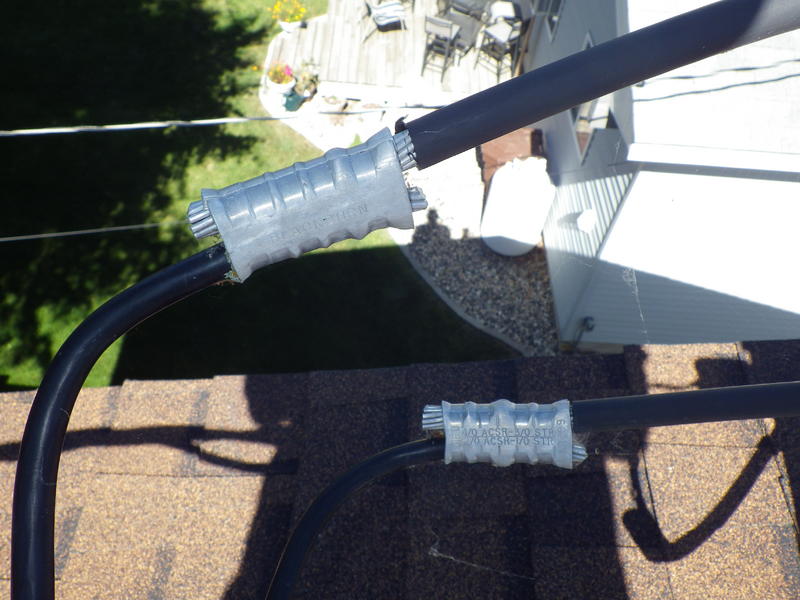Good day America’s finest. I came upon this situation while on a roof yesterday. When I see something which appears to me to be this blatantly in error, I wonder if there is something I do not know (there’s lots of that but I mean in this case) I reported main power connections as completely out in the open and unprotected. If there were broken pieces of a case that would be different but there was nothing. The roof is recently reshingled and wouldn’t someone else notice that? Either by sight or contact. Also the weather head and power line are only two feet above the roof. I have heard electricians speak of not being overly concerned about power in the upper parts of houses because they are so far removed from the ground and the materials between them and ground are but minimally conductive. Personally I have been lit up too many times to trust anything. I reported the situation as a hazard and recommended they contact the power company who may own that part of the system and therefore be responsible for repairs. Tell me if I am in error here, I’m open to correction.
mike in MN
Got a pic with a larger overview of the service drop? I’m not seeing an issue yet.
If I remember correctly the the service connection point should be insulated.
Mike… there is only one opinion that matters… that of your local PoCo. Call them for their opinion.
Yep!
Thanks for the replies. Jeff, no better picture…I just figured that uninsulated connections would be intrinsically dangerous in any situation and especially here I don’t know exactly how much power there is there but what I would presume to be (in technical terms) a ‘butt load’. It may be removed from the ground but as an adamant believer in the first law of Murphy I imagine scenarios like somebody putting a ladder up there and grabbing the splice…now we’re connected well. I called the power company per your suggestion and talked to a service rep who said that if he had installed it he would have taped it up, but didn’t know if there was any code that required that. Well im surprised but ok. I would probably mention that situation as at least ‘suspect’ I have seen plastic cases over these connections which are obviously specifically for that use, and even the ‘tape’ remark surprises me. Of course I’ve come across older taped splices with the tape dried and hanging from the splice. Well I guess chalk it up to another subjective matter.
your inputs appreciated!
mike in MN
I don’t care what the PoCo says, nor do I care what the AHJ says - I’m calling this out for correction, period.
No problem Mike. I find those connections ranging from plastic caps to electricians tape to exposed on a daily basis, with no rhyme or reason for any which may be used. Laziness? Probably. PoCo’s generally don’t give a damn about code. They are the self-appointed Gods of electricity to the home. Make note of who you spoke with, and the particulars, and file it away for future reference. You may need it sometime. Good luck.
thanks again. as a guy who has been powered up and energized several times I will remain in agreement with Mr. Pope. Also finding out that power companies may not abide by predictable standards (in certain cases) is good to know. this is all great input
mike in MN
I agree.
If an electrician has to disconnect the line at that point to change out/repair the service you’ll find a number of different splice connectors used and usually just electrical tape or mastic or a combination of the two will be used to insulate it…and that only lasts so long. The power company most always uses those caps.
Differences between “the Cities” and “the Fields”! ![]()
Whomever those “electricians” are I would steer clear of them. Irrespective of the distance to ground OR the insulating material, contact between the 2 UNGROUNDED conductors is far more dangerous than between one and ground!!! I suspect they are Romex jockeys that have only a marginal understanding of current flow.
Electrocution can result when the body makes contact either with a conductor and ground, OR two or more conductors at different potentials (voltages), OR between portions of ONE SINGLE CONDUCTOR. Yes, you read that correctly, you can be electrocuted by a SINGLE CONDUCTOR!!!
Yet William this is everywhere in SSM On. I always recommend insulators on all houses that have exposed ends. I have seen many scary conditions with Vinyl siding companies and roofers so close to the lateral or service line and no insulators that they could reach out and touch them.
Always with the wrong ladders on the job.
What I am finally seeing is ESA start to put wrapping around the lines that are close to the roof, and all new installs have insulator covers, so changes are in the works.
BTW with that ALL CAPS are you shouting this out!!! LOL
